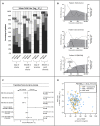Neutralizing Antibody-Mediated Response and Risk of BK Virus-Associated Nephropathy
- PMID: 29042457
- PMCID: PMC5748919
- DOI: 10.1681/ASN.2017050532
Neutralizing Antibody-Mediated Response and Risk of BK Virus-Associated Nephropathy
Abstract
BK virus-associated nephropathy (BKVAN) causes renal allograft dysfunction. The current management of BKVAN relies on pre-emptive adaptation of immunosuppression according to viral load monitoring. However, this empiric strategy is not always successful. Therefore, pretransplant predictive markers are needed. In a prospective longitudinal study, we enrolled 168 kidney transplant recipients and 69 matched donors. To assess the value of BKV genotype-specific neutralizing antibody (NAb) titers as a predictive marker for BKV replication, we measured BKV DNA load and NAb titers at transplant and followed patients for 24 months. After transplant, 52 (31%) patients displayed BKV replication: 24 (46%) patients were viruric and 28 (54%) patients were viremic, including 13 with biopsy-confirmed BKVAN. At any time, patients with high NAb titers against the replicating strain had a lower risk of developing BKV viremia (hazard ratio [HR], 0.44; 95% confidence interval [95% CI], 0.26 to 0.73; P=0.002). Each log10 increase in NAb titer decreased the risk of developing viremia by 56%. Replicating strains were consistent with donor transmission in 95% of cases of early BKV replication. Genotype mismatch between recipients' neutralization profiles before transplant and their subsequently replicating strain significantly increased the risk of developing viremia (HR, 2.27; 95% CI, 1.06 to 4.88; P=0.04). A NAb titer against the donor's strain <4 log10 before transplant significantly associated with BKV replication after transplant (HR, 1.88; 95% CI, 1.06 to 3.45; P=0.03). BKV genotype-specific NAb titers may be a meaningful predictive marker that allows patient stratification by BKV disease risk before and after transplant.
Keywords: Predictive marker; Viral infection; immunology; kidney transplantation; transplant outcomes.
Copyright © 2018 by the American Society of Nephrology.
Figures





Comment in
-
The Authors Reply.J Am Soc Nephrol. 2018 May;29(5):1578. doi: 10.1681/ASN.2018010027. Epub 2018 Feb 21. J Am Soc Nephrol. 2018. PMID: 29467142 Free PMC article. No abstract available.
-
Antibodies Can Extenuate Polyomavirus Infections.J Am Soc Nephrol. 2018 May;29(5):1577. doi: 10.1681/ASN.2017111211. Epub 2018 Feb 21. J Am Soc Nephrol. 2018. PMID: 29467143 Free PMC article. No abstract available.
Similar articles
-
Currently recommended BK virus (BKV) plasma viral load cutoff of ≥4 log10/mL underestimates the diagnosis of BKV-associated nephropathy: a single transplant center experience.Transpl Infect Dis. 2014 Feb;16(1):55-60. doi: 10.1111/tid.12164. Epub 2013 Nov 12. Transpl Infect Dis. 2014. PMID: 24283677
-
Prospective study of polyomavirus type BK replication and nephropathy in renal-transplant recipients.N Engl J Med. 2002 Aug 15;347(7):488-96. doi: 10.1056/NEJMoa020439. N Engl J Med. 2002. PMID: 12181403
-
Composition of the neutralising antibody response predicts risk of BK virus DNAaemia in recipients of kidney transplants.EBioMedicine. 2024 Dec;110:105430. doi: 10.1016/j.ebiom.2024.105430. Epub 2024 Nov 15. EBioMedicine. 2024. PMID: 39546852 Free PMC article.
-
Different behaviour of BK-virus infection in liver transplant recipients.World J Gastroenterol. 2016 Jan 28;22(4):1532-40. doi: 10.3748/wjg.v22.i4.1532. World J Gastroenterol. 2016. PMID: 26819520 Free PMC article. Review.
-
BK polyomavirus infection and nephropathy: the virus-immune system interplay.Nat Rev Nephrol. 2011 May 24;7(7):399-406. doi: 10.1038/nrneph.2011.59. Nat Rev Nephrol. 2011. PMID: 21610680 Review.
Cited by
-
Molecular Characterization of BK Polyomavirus Replication in Allogeneic Hematopoietic Cell Transplantation Patients.J Infect Dis. 2023 Apr 12;227(7):888-900. doi: 10.1093/infdis/jiac450. J Infect Dis. 2023. PMID: 36409589 Free PMC article.
-
Pretransplant BK Virus-Specific T-Cell-Mediated Immunity and Serotype Specific Antibodies May Have Utility in Identifying Patients at Risk of BK Virus-Associated Haemorrhagic Cystitis after Allogeneic HSCT.Vaccines (Basel). 2021 Oct 22;9(11):1226. doi: 10.3390/vaccines9111226. Vaccines (Basel). 2021. PMID: 34835157 Free PMC article.
-
Usefulness of BK virus-specific interferon-γ enzyme-linked immunospot assay for predicting the outcome of BK virus infection in kidney transplant recipients.Korean J Intern Med. 2021 Jan;36(1):164-174. doi: 10.3904/kjim.2019.339. Epub 2020 Apr 3. Korean J Intern Med. 2021. PMID: 32241081 Free PMC article.
-
BK Polyomavirus-associated nephropathy - diagnostic and treatment standard.Nephrol Dial Transplant. 2025 Apr 1;40(4):651-661. doi: 10.1093/ndt/gfaf002. Nephrol Dial Transplant. 2025. PMID: 39794277 Free PMC article. Review.
-
Development of BK polyomavirus-associated nephropathy risk prediction in kidney transplant recipients.Ren Fail. 2025 Dec;47(1):2509785. doi: 10.1080/0886022X.2025.2509785. Epub 2025 May 29. Ren Fail. 2025. PMID: 40438033 Free PMC article.
References
-
- Hirsch HH, Knowles W, Dickenmann M, Passweg J, Klimkait T, Mihatsch MJ, Steiger J: Prospective study of polyomavirus type BK replication and nephropathy in renal-transplant recipients. N Engl J Med 347: 488–496, 2002 - PubMed
-
- Hirsch HH, Randhawa P; AST Infectious Diseases Community of Practice : BK polyomavirus in solid organ transplantation. Am J Transplant 13[Suppl 4]: 179–188, 2013 - PubMed
-
- Hirsch HH, Vincenti F, Friman S, Tuncer M, Citterio F, Wiecek A, Scheuermann EH, Klinger M, Russ G, Pescovitz MD, Prestele H: Polyomavirus BK replication in de novo kidney transplant patients receiving tacrolimus or cyclosporine: A prospective, randomized, multicenter study. Am J Transplant 13: 136–145, 2013 - PMC - PubMed
-
- Binet I, Nickeleit V, Hirsch HH, Prince O, Dalquen P, Gudat F, Mihatsch MJ, Thiel G: Polyomavirus disease under new immunosuppressive drugs: A cause of renal graft dysfunction and graft loss. Transplantation 67: 918–922, 1999 - PubMed
-
- Kuypers DR: Management of polyomavirus-associated nephropathy in renal transplant recipients. Nat Rev Nephrol 8: 390–402, 2012 - PubMed
Publication types
MeSH terms
Substances
LinkOut - more resources
Full Text Sources
Other Literature Sources
Medical

